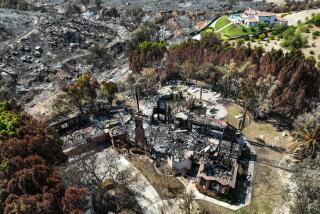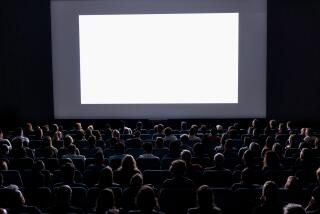Riots Change Place Where Many Shop : Retailing: A lot of stores in Little Tokyo, Koreatown and elsewhere are hurting. But malls near damaged areas are booming.
In Los Angeles’ Little Tokyo, hurt by a sharp riot-related drop in tourism, retail sales have declined 40% to 50% in the past three months, compared to the same period a year ago, and there is talk about bankruptcies and business closings.
At the Baldwin Hills Crenshaw Plaza, however, retail sales have increased 20% to 30% since May 1, compared to that three-month period in 1991, and mall managers are talking about new store openings.
Three months after the riots, the retail scene in Los Angeles is changing. While the drop in tourism has hurt some retail centers, some of the city’s big enclosed malls and larger retailers are making sales gains as consumers search for alternatives to the small shops and swap meets destroyed during the disturbances.
And many food giants are poised to fill a supermarket vacuum that expanded with the riot-related loss of grocery stores in sections of South Los Angeles.
Some of this apparent shopping shift also stems from the weak economy, which has prompted consumers to seek the discounts that big retail chains and shopping centers commonly offer, shoppers and retailers say.
“The strong are getting stronger, and many small retailers are really hurting,” said Jack Kyser, an economist at the Los Angeles-based Economic Development Corp., a nonprofit business development group. “There appears to be a significant shift in buying habits. Apparently, there’s more one-stop shopping.”
Since the riots in late April, the retail story in Los Angeles has been a tale of two cities. For some merchants, it has actually been the best of commercial times. For others--those in Koreatown, for example--it has been terrible.
The riots were a cataclysmic event that left much of the city’s retail base reeling or in ruins. A recent field survey by Dun & Bradstreet Corp., the New York-based business services giant, identified 2,314 businesses damaged or destroyed during the riots, and 64% of those enterprises were retail operations. Dun & Bradstreet officials say the figures may represent only half of the businesses actually affected.
The impact was felt throughout Los Angeles and some neighboring communities, but businesses in South Los Angeles and Koreatown were among the hardest hit. Most of the retail operations affected were small businesses selling goods such as clothing, food, consumer electronics and furniture--merchandise available at competing malls and large department stores.
“The riots have had a definite impact on the retail sector,” Kyser said. “But it’s often difficult to determine what is attributable to the riots and what is related to the rotten economy.”
Little Tokyo in downtown Los Angeles is a clear casualty of riot-related jitters. Many Little Tokyo gift shops and department stores, enterprises that depend on tourists for much of their sales, have suffered from an abrupt drop in tourism.
“After the riot, sales (in Little Tokyo) began to tumble,” said Yoshinori Takamine, president of the 170-member Little Tokyo Business Assn. “People in Japan are not coming to Los Angeles because they are frightened. Many people (in Little Tokyo) will have to close their business by the end of the year if the situation doesn’t change.”
Takamine said sales in Little Tokyo are down 40% to 50% since May 1, compared to the same period last year. Japan’s flagging economy may also account for some of the decline in Japanese tourism.
Frank Kawabe, president of the Japanese Chamber of Commerce of Southern California, says 50% of the businesses in Little Tokyo may fail by the end of the year if there is no rebound.
One of the businesses where sales are down is Mickey Seki & Son, which sells and repairs watches and jewelry, said owner Patrick Seki, who has managed the shop for 20 years.
“This is the worst situation since I’ve been running the business,” Seki said.
Likewise, the situation is becoming desperate for many merchants in Koreatown--an area bounded on the east by Vermont Avenue, on the west by Western Avenue, on the south by Olympic Boulevard and on the north by 8th Street.
Koreatown business--which includes a mix of furniture shops, grocery outlets, consumer electronics stores, restaurants and clothing stores--is down 30% to 40% in the past three months, compared to the same period last year, said Chull Huh, secretary-general of the Korean Chamber of Commerce.
Huh said 2,500 Korean and Korean-American enterprises were damaged or destroyed in the Los Angeles area and many owners of those businesses now have little money to spend in Koreatown. Also, many Koreatown merchants lost inventory to looters--leaving them less to sell. In addition, tourism spending in Koreatown is down since the riots because fewer Koreans are vacationing in Los Angeles, Huh said.
The story is very different at the Baldwin Hills Crenshaw Plaza. That mall’s managers are expecting a significant increase in tenants in coming months. Sales climbed 30% in May and June, compared to last year, and were up 20% to 30% in July, according to the mall’s management.
Among those who have changed their shopping venue is Fred Taylor, who recently purchased a pair of shoes at the Payless Shoe store at the Baldwin Hills mall because another Payless Shoe location in the area was damaged during the riots.
“I hadn’t shopped at the mall much in the past, but I’ll be coming here more often,” he said.
“Initially we were surprised by the big surge,” said Leopold Ray-Lynch, general manager at Baldwin Hills. “But when you analyze the situation, it should have been expected, because the mall is safe and secure and was unscathed after the riots.”
Ray-Lynch said the Baldwin Hills mall, on Crenshaw Boulevard at Martin Luther King Boulevard, is attracting residents who had patronized stand-alone stores, strip malls and swap meets before those businesses were damaged or destroyed during the riots.
“As a result of the riots, some potential tenants are taking a new look at this area because they see opportunities,” Ray-Lynch said.
Indeed, major food retailers are already staking out new sites in South Los Angeles. For example, Vons Cos. announced last month that it plans to open seven markets in South Los Angeles, Compton, Carson and a sector of the county running from South Gate to Paramount. Vons executives said they have neglected South Los Angeles in the past.
And Food 4 Less, which operates warehouse stores and the Boys and Viva supermarkets, plans to build two stores in South Los Angeles.
Also, Smart & Final, which owns discount stores that sell food products in bulk, are looking to expand in South Los Angeles because sales at its existing stores in the area have been strong, said Roger M. Laverty, president of the Vernon-based retailer.
The company will have an Aug. 19 groundbreaking for a new store at Crenshaw Boulevard and 29th Street. Among the other sites on Smart & Final’s expansion list are Vermont Avenue and 83rd Street and locations in Inglewood and Huntington Park.
All three companies will likely draw business away from independent supermarkets and small corner groceries. Many of the mom-and-pop businesses were damaged during the riots.
“Since the riots, we are more aggressively looking for other locations,” Laverty said. “In the wake of the riots, there may be new real estate available. We’re talking to companies who may not rebuild their damaged property.”
Some industry analysts expect other retail giants to develop or expand a presence in Los Angeles--squeezing smaller retailers even more.
“There are some drawbacks to doing business in Los Angeles,” observed Mel Feierstein, an economist and consultant at Dun & Bradstreet. “However, the conglomerates and chains will not forfeit that market. I don’t think there will be a decrease in consumer spending as a result of the riots. If someone needs something and there are no retailers nearby, they’ll find another place to make the purchase.”
Apparently, more shoppers are deciding to make their purchases at the Westside Pavilion in Los Angeles. There have been no surveys to indicate why more shoppers are turning to that mall, but Westside Pavilion had a whopping 54% increase in customer traffic in July compared to July, 1991, according to the shopping center’s security people.
Mary Lankester, senior marketing director at the mall, said mall events featuring entertainment and craft activities for children may have helped lure crowds. The Pavilion has not compared sales in July against a year ago, but sales were up 5% in May and June, Lankester said.
“Considering the environment--a recession and complications related to the riots--we weren’t expecting a 5% increase,” Lankester said. “And a 54% increase in traffic was certainly above our expectations.”
Customer traffic is also up significantly at the Hawthorne Plaza mall, said Bill Demarest, the shopping center’s general manager. May sales were flat compared to May, 1991, but June sales were up 10% and July’s about 5%, Demarest said.
Demarest said Hawthorne Plaza is probably attracting shoppers from neighboring South Los Angeles and Hawthorne who formerly patronized open-air strip malls, small operations that were damaged during the riots in some cases.
More to Read
Inside the business of entertainment
The Wide Shot brings you news, analysis and insights on everything from streaming wars to production — and what it all means for the future.
You may occasionally receive promotional content from the Los Angeles Times.






